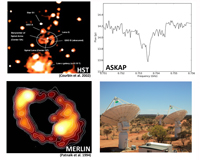First absorption line for ASKAP4 December 2013 CSIRO's ASKAP commissioning team has achieved a new science demonstration with the first HI absorption line measured with ASKAP antennas at the Murchison Radio-astronomy Observatory (MRO) in Western Australia. The result successfully demonstrates that the HI spectral line mode of ASKAP reproduces faithful results in a well-characterised astronomical region, and is an important step towards ASKAP Early Science. Using three ASKAP antennas installed with ASKAP's first generation phased array feed (PAF) receiver system and the hardware correlator, a baseline-averaged cross correlation spectrum was produced of the gravitationally-lensed system PKS 1830-211 (the discovery of which was presented in a Nature article in 1991). This system has an absorbing galaxy at a redshift of z=0.89. A six hour observation of the source was conducted with the three baselines; the data were captured at full spectral resolution using the full bandwidth of the hardware correlator. For a very simple reduction the amplitude was determined for each visibility and these amplitudes were then averaged across the duration of the observation and over the three baselines. The image above (click to see more detail) is a montage of the configuration of the source (an optical image of the gravitationally lensed system from HST), a picture of the Einstein Ring (from MERLIN) and the ASKAP HI absorption spectrum produced by the commissioning team. The prominent HI absorption feature from an intervening galaxy, at z=0.89, can be seen at a frequency of 753.5 MHz. This demonstration continues the commissioning tests underway at the MRO following the installation of six PAF receiver systems and associated digital systems, hardware correlator and beamformer, which form the Boolardy Engineering Test Array (BETA). ASKAP Survey Science Team members are welcome to access the raw data - please contact ASKAP Project Scientist Lisa Harvey-Smith for more information. Interesting tidbit: This is not the first time that ATNF telescopes have studied PKS 1830-211. CSIRO's Parkes and ATCA telescopes were involved in VLBI observations that led to the source being identified as a radio Einstein Ring — the strongest one known at that time (Nature, 1991). Back to Latest ASKAP News page. |
This loads a font easier to read for people with dyslexia.
This renders the document in high contrast mode.
This renders the document as white on black
This can help those with trouble processing rapid screen movements.

